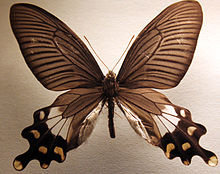Byasa latreillei
| Rose Windmill | |
|---|---|

| |
| Scientific classification | |
| Kingdom: | |
| Phylum: | |
| Class: | |
| Order: | |
| Family: | |
| Genus: | |
| Species: | B. latreillei
|
| Binomial name | |
| Byasa latreillei[1] | |
Byasa latreillei, or Rose Windmill, is a butterfly found in various parts of Asia from the Windmills genus Byasa, comprising tailed black swallowtail butterflies with white spots and red submarginal crescents.
Description
- Wingspan : 110 - 130mm.
- Sexes generally alike. Tailed, with red tips.
- Above, dull brownish-black.
- Hindwing has a white discal band consisting of elongated spots in veins 2, 3 and 4.
- The female has an additional small spot in vein 5 and only half way to vein 6.
- It also has a series of lunules in veins 2 to 5 along the margin. The lunules in veins 2 to 4 are rose coloured while the lunule in vein 5 is white.
- The male has a white scent wool brand in a dorsal fold. (Wynter-Blyth).
- The male can be said to resemble the Common Rose, and, the female, the Common Mormon form stichius. (Haribal).
Male upperside dull brownish black. Fore wing with streaks in cell, the internervular streaks and the veins velvety black. Hind wing: ground-colour more uniform to apex of cell, beyond this interspaces 2, 3 and 4 with broad elongate white spots, the spot in interspace 2 slightly tinged outwardly with crimson; sometimes a white crimson-tinted spot also in interspace 1; a subterminal series of crimson lunules in interspaces 2 to 5, that in 5 generally more or less white ; lastly, a crimson spot at apex of vein 3 and on apex of tail. Underside similar, ground-colour much paler; markings of the hind wing as on the upperside, but slightly larger, the crimson spots brighter; in many specimens a small discal adnervular spot in interspace 5, and a sub-terminal small white lunule in interspace 6 also present; the crimson-tinted discal spot in interspace 1 always present. Antennae dark brownish black, head and front of the prothorax crimson, the rest of the body above black; beneath, the palpi, thorax and abdomen crimson, the middle of the thorax and of the abdomen with black markings.
Female Similar, slightly paler; the white and crimson markings on the hind wing on both upper and undersides similar but larger ;there is generally also a discal adnervular spot in interspace 5. Antennae, head, thorax and abdomen as in the male.[2]
Life history
- Egg - not described.
- Caterpillar - The larva is brownish to pale purple in colour. The larva has a shiny black head and a white obliquely-placed band on segments seven and eight. It has a large number of tubercles. The first six segments of the larva have one pair of tubercles; the seventh to tenth segments have three pairs each; the eleventh to thirteen segments each have two pairs of short tubercles. The tubercles are purple, have red tips and streaks on the base.
- The pupa is reddish-orange in colour and relatively broad in shape. It is attached by a body band. The pupa emits a squeak when touched.
Habits
- It flies in May and June. It flies between 7000 and 9000 feet in Garhwal (near Mussoorie) and between 5000 and 6000 feet further east at Chungthang, North Sikkim in the Teesta valley.
- The host plant include Nepenthes species.
Range
Afghanistan, Pakistan, North India, Nepal, Bhutan, northern Myanmar, southern China and northern Vietnam.
In India, it is found in the states of Uttarakhand, Sikkim, Assam, Meghalaya, Nagaland and Manipur.
Status
It is not rare and not regarded as threatened. Subspecies A. l. kabrua is protected by law in India. Requires more information.[3]
Taxonomy
Three subspecies are described of which the following two occur in India :
- B. latreillei latreillei Donovan. Garhwal to Sikkim. Not rare.
- B. latreillei kabrua Tytler. Assam to North Myanmar. Not rare.
Etymology
The specific epithet honours the French entomologist Pierre André Latreille.
See also
Cited references
- ^ a b Häuser, Christoph L.; de Jong, Rienk; Lamas, Gerardo; Robbins, Robert K.; Smith, Campbell; Vane-Wright, Richard I. (28 July 2005). "Papilionidae – revised GloBIS/GART species checklist (2nd draft)". Entomological Data Information System. Staatliches Museum für Naturkunde Stuttgart, Germany. Retrieved 21 June 2013.
- ^ Bingham, C. T. 1907. Fauna of British India. Butterflies. Volume 2
- ^ Collins, N.M. & Morris, M.G. (1985) Threatened Swallowtail Butterflies of the World. IUCN. ISBN 978-2-88032-603-6 pdf
References
- Evans, W.H. (1932) The Identification of Indian Butterflies. (2nd Ed), Bombay Natural History Society, Mumbai, India
- Haribal, Meena (1994) Butterflies of Sikkim Himalaya and their Natural History.
- Wynter-Blyth, M.A. (1957) Butterflies of the Indian Region, Bombay Natural History Society, Mumbai, India.
External links
- Global Butterfly Information System text, images including Holotype of robus Jordan, 1928
